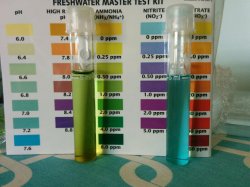I put water and conditioner in the tank a few days ago but finally got around to starting the cycle. All parameters were fine (ammonia 0, nitrites 0, nitrates 0, pH 7) in my initial water, which is from a water dispenser in town. I live in the country and have very hard well water so we decided to buy water, which is filtered RO water.
I bought Dr Tim's ammonia and added the 1 drop per gallon as instructed on the bottle (which is supposed to come out to 2 ppm or whatever). I also added some tetra safe start plus. So I'll test it in a bit and now the wait starts.
In a few days I'll start it all over again on my daughter's tank.
I bought Dr Tim's ammonia and added the 1 drop per gallon as instructed on the bottle (which is supposed to come out to 2 ppm or whatever). I also added some tetra safe start plus. So I'll test it in a bit and now the wait starts.
In a few days I'll start it all over again on my daughter's tank.


